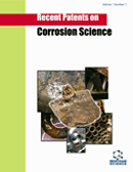Abstract
A simultaneous in situ optical microscopy and simultaneous electrochemical analysis method is presented for studying 316L stainless steel in hydrometallurgical process solutions. The electrochemical method involved potentiodynamic analysis of the 316L stainless steel surface in aerated and deaerated experimental hydrometallurgy process fluids. This technique is reviewed along with other potentiodynamic methods used in stainless steels, recent patents on stainless steel technologies, and the results are discussed in conjunction with various theories and applications. The results illustrate a wide variety of corrosion behaviors (active, passive, anodic knee) and parameters (corrosion rate, pitting potential, mixed potential, pH) possible for 316L stainless steel under potentiodynamic test conditions. Analysis of these samples provides both a detailed visual account of the corrosion process in addition to standard electrochemical analysis regarding pitting potential, corrosion potential and corrosion rate. Polarization data and analysis with respect to the corrosion patterns observed is presented including in situ images of surface layer changes, etching, pitting and microstructure. Analysis of copper sulfide inclusions and metal surface film behaviors in solution were performed showing the tendency of inclusions and film to dissolve and act as nucleation sites for pits. The proprietary experimental hydrometallurgical process fluids tested further support the ability of in situ optical microscopy to successfully image and provide valuable insights into the corrosion processes taking place.
Keywords: In situ, optical, potentiodynamic, polarization, SEM-EDS, etching, pitting, inclusions, grain boundaries, aerated, deaerated, 316L, hydrometallurgical process solutions.
 32
32







